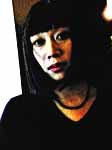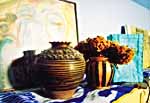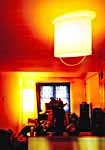Gao Bo has reason to be happy. For the past two years
the professional photographer has lived and worked
out of his home in the peaceful suburban countryside
of Changping county, north of Beijing. Far from the
chaos of downtown, the house sits at the end of a
weaving labyrinth of brick courtyard-style houses
lined with ancient persimmon trees.
Today Gao, 36, is showing guests
around his home, which he built from the ground up
by hand. But usually you can find him working in his
cavernous photo studio surrounded by his two passions:
huge and hauntingly beautiful photographs taken from
years of world travel and a small collection of wooden
smoking pipes.
In 1996 the Harbin-born professional
photographer returned to the northeast after years
of wandering across China and Europe. Upon his return,
he made a simple promise to himself: to find a suitable
place to develop his large-format, black-and-white
prints and to find a place to lay down roots.
"Setting up a house is one of humanity's
basic instincts," Gao says. "When a child learns to
draw, one of the first things he draws is a house,
a garden, a tree."
But the more he searched, the more
frustrated he grew. Finding a place in Beijing which
was both large and tranquil enough at a reasonable
cost proved to be almost impossible. Then, by chance,
he passed through one of the many small villages at
the foot of the hills in the western suburbs and stumbled
upon the ideal place.

Discovering that the cost of land
was considerably lower than purchasing one of the
tightly-packed courtyards in inner-city Beijing, Gao
and his wife immediately got an unlimited lease on
a plot owned by the local community.
No building permit was needed.
With only a limited knowledge of architectural planning,
Gao went ahead with the project. He drew inspiration
from the natural curves of the land, the resources
of the countryside and a dash of traditional Chinese
aesthetic savvy, to sketch out his designs. Built
with the help of a somewhat bewildered gaggle of local
engineers, the house is as much an example of resourcefulness
and creativity as it is of architectural beauty.
Walking around Gao's house is like
making your way through a complex maze. The layout
strikes a fine balance between compliance with building
regulations and artistic license. The building itself
is shaped like a nautilus shell, with the front entrance
tucked around the side of the building leading to
an L-shaped living area.
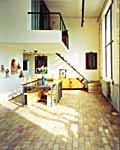
Inside, pinewood steps wind around
the corner of the living room to the main bedroom
above. A cozy office sits to the side on a balcony
overlooking the first floor. Split from the rest of
the house by a wall is a solitary study, which can
only be accessed by a set of wrought-iron stairs.
Framed photos - silent footprints left by Gao's extensive
travel - can be found throughout.
Since he first got his hands on
a manual Nikon camera as a student at the prestigious
Central Academy of Art and Design in Beijing, photography
has been his passion. With a refined eye for documenting
the human face and a keen nose for adventure, Gao
set off on a four-month trek across the high plateaus
of Tibet and spent subsequent vacations taking closeup
portraits of dwellers of China's most remote regions.
In the winter of 1989, his adventures
took him to Paris, where he lived for almost five
years and mastered French. He worked as photographer
for Agence Vu, a local photo news agency, before he
returned to his homeland with his French wife Delphine.
"I have never felt like a stranger,
no matter where I find myself," he says. "In France,
I found ways to blend into my environment. Feeling
at home means creating a feeling of familiarity, a
feeling of comfort with your surroundings."
The eclectic mix of Chinese and
Western sensibilities is a consistent theme with Gao.
He wears his long, black hair tied
back and sports a wispy moustache framing a small
beard - looking a bit like a scholar in a classic
Chinese painting. By contrast, he dresses in chic,
black polo shirts and jeans and sips espressos with
all the finesse of a French existentialist.
Gao sits surrounded by his own
designs, from a stainless steel dining table paired
with pinewood chairs, to pine stairs along the wall.
A Chinese antique rosewood cabinet stands humbly against
the wall, which Gao purchased from a street market
while he was mentally drawing plans for his new home.
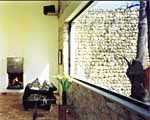
Other fixtures include Chinese
regional artifacts and personal acquisitions. Among
them, a collection of statue deities from Yunnan and
Hebei provinces and the Himalayan Kingdom of Nepal
rest on stone shelves silhouetted against a white
wall. Opposite, a casually sketched self-portrait
hangs modestly between two magnificent Tibetan thangka
prayer hangings.
"You have to be surrounded by objects
that are close to you, that is what makes a place
your home," Gao says. "Everything that I have in my
house I have taken from my life experiences. Most
things were not bought. They come from meeting people
along the way. I collect, but I am not a collector
in the same way that an antique collector buys antiques.
My house is more a collection of memories."






